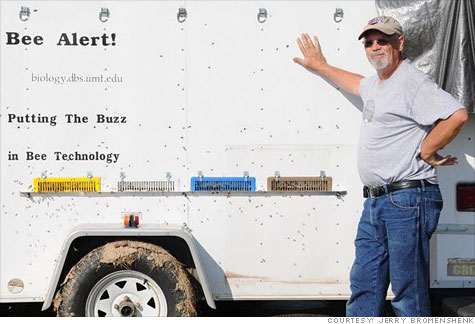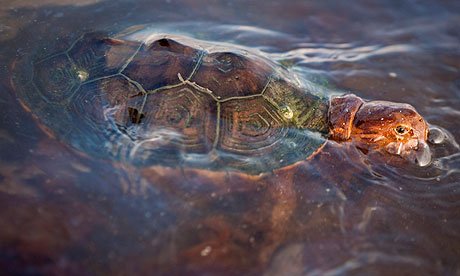 Two months ago, U.S. EPA wrote nine major natural gas drilling companies a letter. It politely asked the recipients to voluntarily tell agency officials the secret brew of chemicals they use to "frack" gas from the shale deposits.
Two months ago, U.S. EPA wrote nine major natural gas drilling companies a letter. It politely asked the recipients to voluntarily tell agency officials the secret brew of chemicals they use to "frack" gas from the shale deposits.
EPA wasn't even planning to make the ingredient list public, a policy the industry is fighting tooth-and-nail in Congress. Instead, it just wanted the information to help with a crucial first-ever federal study of the health and safety risks of hydraulic fracturing, a drilling technique that has already ruined water and air quality in towns across the country and has proceeded unregulated thanks to the Dick Cheney-pushed "Halliburton loophole" passed in 2005.

 Environmental Glance
Environmental Glance The illegal trade in tiger parts has led to more than 1,000 wild tigers being killed over the past decade, a report suggests. Traffic International, a wildlife trade monitoring network, found that skins, bones and claws were among the most common items seized by officials.
The illegal trade in tiger parts has led to more than 1,000 wild tigers being killed over the past decade, a report suggests. Traffic International, a wildlife trade monitoring network, found that skins, bones and claws were among the most common items seized by officials. The long list of possible suspects has included pests, viruses, fungi, and also pesticides, particularly so-called neonicotinoids, a class of neurotoxins that kills insects by attacking their nervous systems. For years, their leading manufacturer, Bayer Crop Science, a subsidiary of the German pharmaceutical giant Bayer AG (BAYRY), has tangled with regulators and fended off lawsuits from angry beekeepers who allege that the pesticides have disoriented and ultimately killed their bees. The company has countered that, when used correctly, the pesticides pose little risk.
The long list of possible suspects has included pests, viruses, fungi, and also pesticides, particularly so-called neonicotinoids, a class of neurotoxins that kills insects by attacking their nervous systems. For years, their leading manufacturer, Bayer Crop Science, a subsidiary of the German pharmaceutical giant Bayer AG (BAYRY), has tangled with regulators and fended off lawsuits from angry beekeepers who allege that the pesticides have disoriented and ultimately killed their bees. The company has countered that, when used correctly, the pesticides pose little risk. With Republicans in control of the House of Representatives, powerful Texans such as Rep. Joe L. Barton of the House Energy and Commerce Committee have vowed to check the Environmental Protection Agency's efforts to use its existing authority to curtail greenhouse gases.
With Republicans in control of the House of Representatives, powerful Texans such as Rep. Joe L. Barton of the House Energy and Commerce Committee have vowed to check the Environmental Protection Agency's efforts to use its existing authority to curtail greenhouse gases. A survey of the seafloor near BP’s blown-out well in the Gulf of Mexico has turned up dead and dying coral reefs that were probably damaged by the oil spill, scientists said Friday. The coral sites lie seven miles southwest of the well, at a depth of about 4,500 feet, in an area where large plumes of dispersed oil were discovered drifting through the deep ocean last spring in the weeks after the spill.
A survey of the seafloor near BP’s blown-out well in the Gulf of Mexico has turned up dead and dying coral reefs that were probably damaged by the oil spill, scientists said Friday. The coral sites lie seven miles southwest of the well, at a depth of about 4,500 feet, in an area where large plumes of dispersed oil were discovered drifting through the deep ocean last spring in the weeks after the spill. BP Plc Chief Executive Officer Robert Dudley expects to drill in the U.S. Gulf for 20 years as the company exploits its experience searching for oil miles below the sea.
BP Plc Chief Executive Officer Robert Dudley expects to drill in the U.S. Gulf for 20 years as the company exploits its experience searching for oil miles below the sea. A historic deal to halt the mass extinction of species was finally agreed last night in what conservationists see as the most important international treaty aimed at preventing the collapse of the world's wildlife.
A historic deal to halt the mass extinction of species was finally agreed last night in what conservationists see as the most important international treaty aimed at preventing the collapse of the world's wildlife.






























